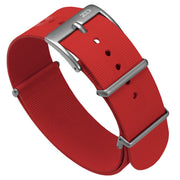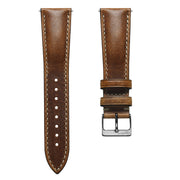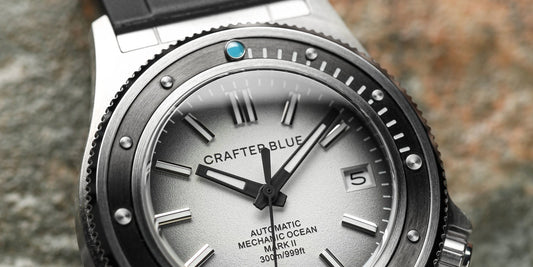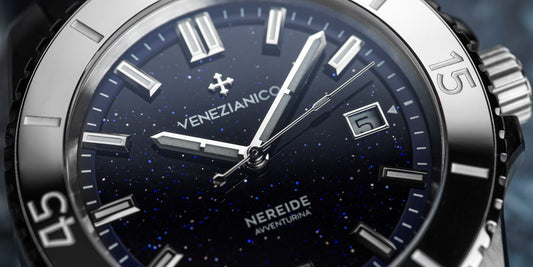How does a Solar Watch work and what are the benefits?
Solar watches essentially power themselves by harnessing energy from solar light sources, i.e. sunlight, or artificial light sources like lamps or overhead lights. This light energy can then be converted into electronic energy which is used to power the rechargeable battery inside the watch. Originally, you’d be most likely to find visible solar cells on the dial of a solar watch, but as time has gone by and technology has modernized, the solar cells are now more subtle, often hidden underneath a light absorbent dial.
 Junghans Max Bill Mega Solar. Credit:Junghans.
Junghans Max Bill Mega Solar. Credit:Junghans.
Reliant on renewable energy, as opposed to any need for electronic intervention, solar watches are often sought out over quartz watches because they don’t need regular battery changes to function. Removing typical disposable batteries from the equation also makes solar watches an eco-friendlier choice with servicing and maintenance rarely required.
What is the life span of a Solar Watch?
Although the life span of a solar watch will naturally vary, you can expect one to last for between 7 to 12 years on average. This doesn’t mean they need no intervention though, as Seiko recommends that servicing takes places every 3 or 4 years. You can get a whole lot of usage from small amounts of exposure to direct sunlight but it’s important to remember that the brighter the light, the faster the charge. Regularly wearing the watch will help too, as the solar cells can extract and store light in a variety of environments, but if you don’t want to wear it, your solar watch can continue to harness energy as long as it’s stored in a well-lit area.
 Inner workings of a Solar Watch - diagram. Credit: Citizen.
Inner workings of a Solar Watch - diagram. Credit: Citizen.
Who invented Solar Watches?
The world’s first solar watch was introduced to the market by American engineer Roger Riehl in 1972. Not so differently from many traditionally made mechanical timepieces at that time, Riehl’s Synchronar 2100 did, in some ways, fall prey to the quartz crisis. At a price point equivalent to around $3000 in today’s climate, the ambitious Synchronar 2100, whilst revolutionary technology at the time, was considered a luxury item and couldn’t quite compete with the vast array of accessible quartz-powered timepieces littering the market.
Roger Riehl sparked a flame though and in the years that followed, the cost of solar technology began to decrease and brands like Citizen made their move on the solar watch market. The Japanese brand released the world’s first solar powered watch with traditional analog display, the Citizen Crystron, not too long after in 1976.
What are the best Solar Watches?
Choosing a solar watch of your own is a somewhat personal decision. You may have a certain budget or brand in mind, and you’ll likely consider the watches you’ve already acquired in your collection and how a new watch will fit into this. The solar watch market is still somewhat niche, but we’ve pulled together a few favourites from some of the brands leading the way.
Timex Expedition North Solar
 Timex Expedition North Star. Credit: Timex.
Timex Expedition North Star. Credit: Timex.
Timex’s Expedition North Solar collection contains a mixture of solar powered field and dive watches and places itself firmly at the more affordable end of the spectrum. With its diver-inspired design, uni-directional bezel and crown guard, the Expedition Freedive Ocean is built with durability in mind, to go where you do, rain or shine. Housed in a chunky 46mm case, it’s a perfect solution for those who are conscious of preserving our planet thanks to its solar-powered Japanese movement that eliminates the changes associated with disposable batteries and its rugged case made from recycled ocean-bound plastic. Prices start from £130.
Seiko SFJ001 Prospex Speedtimer Solar Chronograph
 SEIKO SFJ001 Prospex Speedtimer Solar Chronograph. Credit: SEIKO.
SEIKO SFJ001 Prospex Speedtimer Solar Chronograph. Credit: SEIKO.
The Seiko Speedtimer Solar Chronograph collection currently contains fourteen solar powered references, and each watch is inspired by the iconic style of the Speedtimer series which gained popularity in the late 1960’s and early 1970’s. Equipped with the Seiko solar Caliber V192, each reference has a 60-minute chronograph, 24-hour sub-dial and, at the touch of a button, displays a power reserve indicator. The SFJ001 reference is currently priced at £760.
Tissot T-Touch Connect Solar
 Tissot T-Touch Solar Connect. Credit: Tissot.
Tissot T-Touch Solar Connect. Credit: Tissot.
Ahead of the trend somewhat, the T-Touch was presented by Tissot in 1999 and at the time was the world’s first tactile watch. Seamlessly blending analogue with digital, the T-Touch Connect utilises touch-screen sapphire crystal through which the wearer can track physical activity, record exercise, set timers and alarms, and sync data across popular health apps, such as Apple Health. Built to last and optimised to navigate land sports such as snowboarding, cycling and basketball, the T-Touch Connect Solar can keep all of this up for six months on a single charge from the sun. Priced at £1,000+, the T-Touch Connect Solar is a clever blend of smart and traditional, with features perfect for those who live life on the go.
Citizen Eco-Drive
 Citizen Eco-Drive One. Credit: Mediaworld.
Citizen Eco-Drive One. Credit: Mediaworld.
The Citizen Eco-Drive collection hosts perhaps the most diverse selection of solar watches on the market. As their most prevalent technological advancement, it does feel somewhat fitting that Citizen is still the only brand to have an entire series of models that are dedicated solar watches. With Disney collaborations featuring familiar Star Wars characters to Mickey Mouse himself, as well as dressy ladies’ watches and chronograph references, there is something to suit every wrist. You can get your hands on one of Citizen’s Eco-Drive models for less than £200 but more luxurious limited-edition options might set you back up to £3.5k.
So, if you’ve ever found yourself wondering what a solar watch is and why you might want to buy one, I hope your questions have been answered. If I’ve missed anything, or you want to chat about your experience with solar watches, leave me a comment below!



















